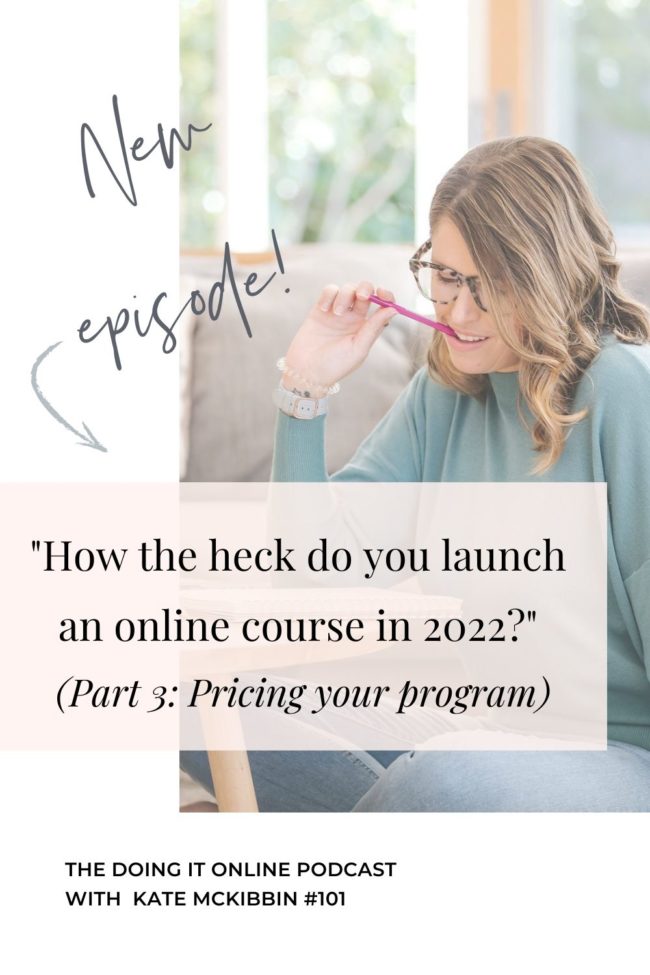TUNE-IN: APPLE PODCASTS | SPOTIFY | GOOGLE PLAY
How do you price your online course? Where do you start? Do you just pull a number out of the air and hope it works?
No.
That’s what this series is for! We’re walking you through how to create and sell (successfully) your online course. And today, in Part 3, we’re talking all about pricing.
How the heck do you launch an online course in 2022? Part 3: Pricing your program.
Over the next few episodes we’re going to get our practical hats on and I’m going to walk you through the process of how to launch your own online course… Step by step.
Things You’ll Learn in this Episode of Doing it Online:
- How to sense-check your pricing to make sure you’re on track for hitting your business goals…
- How to get the balance right between value and price…
- Why lowering your prices isn’t the right answer for more sales. (And why increasing your prices isn’t it either!
It’s the big, juicy question…
How do you price your online program?
There’s no simple answer as there are so many layers involved.
And because of that, this episode itself is pretty epic and full of layers that you’re going to want to listen to. These notes are a great overview, but I don’t want you to miss out on all the details and nuances of this important part of your business…
The win-win
Pricing or selling anything is about creating a win-win exchange. They need to want what you’re offering more than the money in their pocket, and you need to be happy to exchange your time and energy for that money.
It needs to be fair both ways, and it’s something worth taking the time to figure out and get right.
And so to help with that, I’m sharing an exercise with you that we take people through inside eCourse Empire to help them price their programs and offers.
But first, I wanted to share with you how I’ve seen this play out in real life…
From 1 per month to over 40, on auto-pilot…
A previous member had a $4000 high-touch program she sold through sales calls.
However, her program wasn’t converting on those calls.
As we were troubleshooting together about what was going wrong, we realised that she was burnt out and time poor. Which meant that she didn’t actually want to deliver the program the way it was set up, with many live 1:1 calls.
So that mindset was affecting her ability to sell the program. Because, fun fact: if you don’t actually want to deliver something…you’re sure as heck not going to want to sell it.
Secondly, her target market of time-poor mothers weren’t valuing the outcome enough to invest huge amounts of time and money at this stage in their lives.
It wasn’t a fair, win-win exchange.
After all this strategising, she went back to her offer and revamped it into a much lower-touch (no 1:1’s) program and priced it at $500.
The outcome? She went from barely selling 1 program a month, to selling around 40 per month, on autopilot.
Pricing your course: the numbers matter
Don’t let the takeaway from this example be “I just need to reduce my prices.” Because that’s not it. In fact, if your program is too cheap, it can hurt your sales.
People make assumptions based on the number you give it.

If there’s a disconnect between the price and where people think it sits on the “value scale,” people won’t buy, or won’t be happy if they do.
I have an amazing example of this from a friend of mine, not a client, who had a high-ticket program that was selling well, but now is even selling even better at a much higher price point…
I dive into her story in more detail in the episode, so give that a listen. But hopefully this gives you an insight into the delicate dance pricing can be, and that yes, it does take time to get it right.
So how do you figure out what pricing works for you?
Let’s break it down. As promised, let’s go through a simplified version of the exercise we take people through in eCourse Empire to help make this all very doable..
Finding your range
Your first step is to go and do some research into what I call “the range.”
You need to find what people in your target market are currently paying for this solution in both the low-end (things like e-books) and high-ticket offers. (High levels of support programs and masterminds etc.)
Once you’ve done that and gathered some data, you need to think about where you are going to strategically place yourself within that range. (And if you’ve gone through the other steps in this series, you should have some idea of the format of your course.) Is your program more DIY, with no live components or feedback? Or does it have high levels of support?
Your pricing should excite you…
Then you want to look at your “second range” or where you want to start your pricing. You should probably have a range of between a couple hundred dollars or maybe a thousand dollars. I recommend if you haven’t sold many things online before, to start at the lower end of your range, so you can build your confidence to charge higher.
Usually, most people have an idea of how much it should cost, but that price feels too scary for them to put out there…yet.
So, I encourage you to pick a price that feels right in your gut, but a tiny bit scary and exciting…but not too much.
Your pricing should excite you. (While still reflecting the value offered.)
I go into this more in the episode so make sure you get the full scoop if you need a bit of a pep talk around scary pricing.
Remember to sense check!
And lastly, you’ve got to run your numbers.
This is part of the Design phase inside eCourse Empire, where we get people to map out what their business will look like, and then we work backwards, asking questions like:
- What do you need to do that?
- And what does that mean for your business, for your offers?
- Speaking of offers, what kind do you need to have?
- How many do you need?
So this gives them the framework to begin pricing their courses and offers. Then they can sense check their pricing. They’ll be able to see how many sales they need, what kind of offers or pricing they need in order to hit their goals.
For example, if you have a $37 product, and only 800 people on your list, it might turn out that you need to sell a crazy number like 10,000 of those to hit your goals.
So that $37 may not be where you need to be placing your focus right now to have the profit or impact you’re looking for in your business.
We want to make sure that if you’re going to all of this effort to create something and sell it, that it’s going to be a worthwhile use of your time and effort. That’s why it’s so important to know these numbers, and then sense-check your offers against them.
Look at your split payments…
This tip doesn’t really apply during global crises like the pandemic, but generally, when the world is relatively “normal”, one way to check your pricing is to look at your split payments.
If more people are paying in full over the split payment, then you probably could increase your price quite safely and still see your offer convert really well.
If most people are taking the split payment and hardly anyone is taking the pay in full then potentially you are already on the highest end of the scale.
And potentially you could bring the price down a little, or introduce an early bird phase with a discount to help increase conversions.
Want some help with pricing and creating your online course?
There are a few other things to consider like split payments and allowing a margin for marketing etc and if you want to find out more, and would love some help around this, we’ve got a couple of spots open inside eCourse Empire at the moment and we really love to help people get their numbers and pricing right for them.


